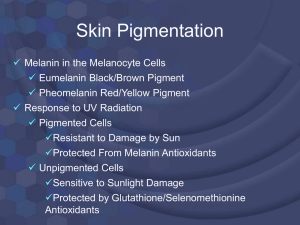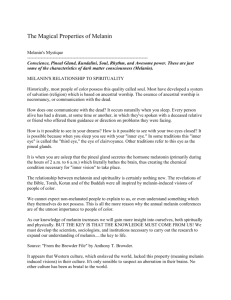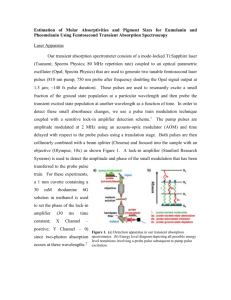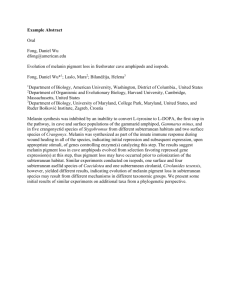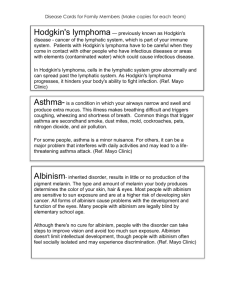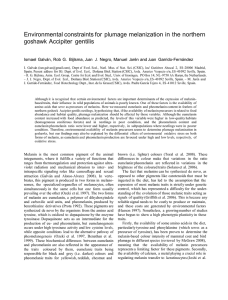Amino acidopathies: defects in amino acid metabolism
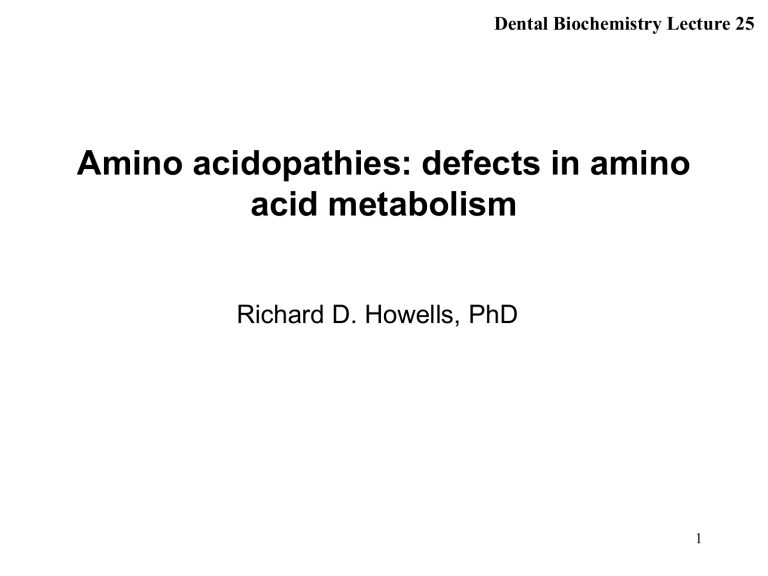
Dental Biochemistry Lecture 25
Amino acidopathies: defects in amino acid metabolism
Richard D. Howells, PhD
1
Learning Objectives
1. To distinguish between phenylketonuria (PKU) caused by phenylalanine hydroxylase (PAH) defect and PKU caused by defect in dihydropterin synthesis or regeneration.
2. To describe clinical symptoms and metabolic intermediates indicative of PKU.
3. To explain the cause and symptoms of albinism and alkaptonuria.
4. To describe metabolic intermediates indicative of albinism and alkaptonuria.
5. To explain the cause and symptoms of maple syrup urine disease (MSUD).
6. To explain the cause and symptoms of homocystinuria.
2
Metabolic defects in amino acid metabolism
• Inborn errors of metabolism are commonly caused by mutant genes that generally result in abnormal proteins, most often enzymes. The inherited defects may be expressed as a total loss of enzyme activity or as a partial deficiency in activity.
• Newborn screening and timely initiation of treatment are essential.
By law, all states must screen for over 20 disorders. All states screen for PKU.
• Treatment: diets low in the amino acids whose catabolism is impaired.
3
A deficiency in phenylalanine hydroxylase results in the disease phenylketonuria (PKU)
4
Phenylketonuria (Hyperphenylalanemia)
• The most common clinically encountered inborn error of AA metabolism (prevalence 1:15,000).
• Elevated levels of phenylalanine (10X normal), phenylpyruvate, phenyllactate, phenylacetate in blood and urine.
• Symptoms: Hypopigmentation, due to inhibition of tyrosinase essential for melanin formation(patients often blond with fair skin and blue eyes);
CNS symptoms : intellectual disability by age one year, developmental delay, microcephaly, and seizures in untreated PKU patients (now rare due to prenatal testing).
• Treatment: dietary restriction of Phe
5
Hyperphenylalanemia may also be caused by deficiencies in any of the several enzymes required to synthesize BH
4 or in dihydropteridine reductase, which regenerates
BH
4 from BH
2
6
Maple syrup urine disease (MSUD)
• Autosomal recessive (1:185,000).
• Partial or complete deficiency in mitochondrial branched chain a
-keto acid dehydrogenase
(BCKD), that oxidatively decarboxylates Leu, Ile and Val.
• These BCAAs and their corresponding a
-keto acids accumulate in blood, causing interference with brain functions (especially Leu and a
-Kic acid).
• Symptoms : a characteristic maple syrup odor to the urine due to rise in Ile; feeding problems, vomiting, ketoacidosis, changes in muscle tone, neurologic problems that can result in coma; if untreated, disease is fatal; if treatment is delayed, intellectual disability results.
• Treatment : Synthetic formula free of BCAAs supplemented with limited amounts of Leu, Ile and Val to allow normal growth and development without producing toxic levels. 7
Albinism
• Results from an absent or defective copper-requiring tyrosinase deficiency
(Incidence; <1:30,000).
• Albinism appears in different forms: autosomal recessive inheritance is primary mode.
• Symptoms : White hair, pink eyes, and hypopigmented pale skin; sensitive to sunlight (easy to sunburn and increased skin cancer); impaired vision, and photophobia.
• Treatment : Protection from
UV exposure.
8
Melanin biosynthesis from tyrosine
9
Melanin
In humans, melanin is the primary determinant of skin color. It is also found in hair, the pigmented tissue underlying the iris of the eye, and the stria vascularis of the inner ear. In the brain, tissues with melanin include pigment-bearing neurons within areas of the brainstem, such as the locus coeruleus and the substantia nigra.
The melanin in the skin is produced by melanocytes, which are found in the basal layer of the epidermis. Albinism results from very little or no melanin synthesis in the body.
There are different types of melanin: pheomelanin and eumelanin are found in human skin and hair, but eumelanin is the most abundant melanin in humans.
10
Eumelanin
Eumelanin polymers are composed of numerous cross-linked
5,6-dihydroxyindole (DHI) and 5,6-dihydroxyindole-2carboxylic acid (DHICA) polymers. Two types are recognized: black and brown. A small amount of black eumelanin in the absence of other pigments causes grey hair. A small amount of brown eumelanin in the absence of other pigments results in blond hair.
Pheomelanin
Pheomelanin imparts a pink to red hue and, thus, is found in particularly large quantities in red hair. Pheomelanin is particularly concentrated in the lips, nipples, glans of the penis, and vagina. In chemical terms, pheomelanin differs from eumelanin in that its oligomer structure incorporates benzothiazine and benzothiazole units that are produced, instead of DHI and DHICA, from tyrosine and cysteine.
11
Homocystininuria
• Group of rare disorders involving defects in metabolism of homocysteine (Hcy).
• Patients exhibit lens dislocation, skeletal abnormalities (long limbs and fingers), intellectual disability, increased risk for developing blood clots.
• Treatment includes restriction of methionine and supplementation with vitamins B
6
, B
12
, and folate.
Homocystinuria is characterized by high plasma and urinary levels of
Hcy and methionine.
12
Association between cardiovascular disease
Mortality and total plasma homocysteine
13
Alkaptonuria
• A rare non-fatal metabolic condition involving a deficiency in homogentisic acid oxidase, resulting in the accumulation of homogentisic acid (HA)- ((2,5dihydroxyphenyl) acetic acid), an intermediate in the degradative pathway of tyrosine (see last slide).
• The condition has 3 characteristic symptoms: homogentisic aciduria (the HA in urine oxidizes to a dark pigment on standing), large joint arthritis that can be severely crippling, and deposition of black pigment in cartilage and collagenous tissue.
• Diets low in Phe and Tyr reduce the levels of HA and decrease the amount of pigment deposited in body tissues.
14
Synthesis and some of the actions of nitric oxide (NO)
• Nitric oxide is synthesized from arginine by nitric oxide synthase (NOS).
• There are 3 nitric oxide synthases encoded by different genes: the endothelial
(eNOS), neural (nNOS) and inducible (iNOS).
• FMN, FAD, heme, and tetrahydrobiopterin are coenzymes, and eNOS and nNOS are Ca 2+ -calmodulin dependent.
15
The Ca 2+ /nitric oxide (NO)/cGMP pathway and the relaxation of arterial smooth muscle
16
Treatment of erectile dysfunction
• The blood vessels in the corpora cavernosa of the penis are expected to dilate profoundly in response to parasympathetic nerve stimulation, with NO being the most important mediator.
• In this tissue, NO is formed mainly in the nerve terminals and only to a lesser extent in the vascular endothelium.
• As in other vascular beds, however, NO acts by stimulating the soluble guanylate cyclase in vascular smooth muscle.
• Erectile dysfunction (impotence) is treated with sildenafil
(Viagra) and related drugs that inhibit phosphodiesterase-5.
• This cGMP-specific phosphodiesterase is responsible for the degradation of cGMP in the vascular smooth muscle of the penis.
17
Key concept map for nitrogen metabolism
18
Summary of the metabolism of amino acids in humans
19

